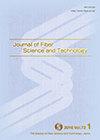Application of Atmospheric Pressure Plasma Oxidation and Plasma-Induced Polymer Coating to Surface Functionalization of Textiles
IF 0.3
4区 工程技术
Q4 MATERIALS SCIENCE, TEXTILES
引用次数: 2
Abstract
: Surface functionalization of fibers is one of powerful meanings for improvement of textile performances. In this review, two atmospheric pressure plasma jets (APPJ), plasma oxidation with nitrogen gas and plasma-induced polymer coating with hexamethyldisiloxane, are utilized for the surface functionalization of synthetic fibers, poly (ethylene terephthalate), PET. The PET film with a geometrical simplicity and natural fiber, wool, are also used as materials. The topographical and chemical changes due to the plasma‒PET surface interaction are clearly observed after the APPJ treatments. The APPJ oxidation roughens the PET surface as well as increases the surface atomic oxygen concentration, which makes it hydrophilic. However, remarkable hydrophobization is achieved after the APPJ coating as a result of the deposition of inorganic SiO 2 films and the granular morphology formation on the PET surface. The APPJ oxidation after the APPJ coating makes the PET surface super-hydrophilic. Surprisingly, the APPJ-coated PET surfaces with and without the APPJ oxidation have no contact angle hysteresis and preserve the contact angle to remain almost constant for at least two weeks. With respect to textile performance, the antifouling property of the PET fabric is found to be controlled by the APPJ treatments: soil deposition in air is prevented after the APPJ coating and soil release by laundering is promoted by the APPJ oxidation to the pristine and the APPJ-coated PET fabrics. Water wicking into the PET and wool fabrics is remarkably promoted by the APPJ oxidation. The dyeability of the PET fabric by dispersive dyes is improved by the APPJ oxidation before dyeing. For the wool fabric, color deepening after ink-jet dyeing is significantly increased due to pretreatment by the APPJ oxidation compared with the chemical treatment.常压等离子体氧化及等离子体诱导聚合物涂层在纺织品表面功能化中的应用
纤维的表面功能化是提高纺织品性能的重要意义之一。本文介绍了两种常压等离子体射流(APPJ),即氮气等离子体氧化和等离子体诱导的六甲基二硅氧烷聚合物涂层,用于合成纤维聚对苯二甲酸乙酯(PET)的表面功能化。几何形状简单的PET薄膜和天然纤维羊毛也被用作材料。经APPJ处理后,等离子体- pet表面相互作用引起的形貌和化学变化清晰可见。APPJ氧化使PET表面变得粗糙,并增加了表面原子氧浓度,使其具有亲水性。然而,APPJ涂层后,由于无机sio2薄膜的沉积和PET表面颗粒形态的形成,实现了显著的疏水性。APPJ涂层后的APPJ氧化使PET表面具有超亲水性。令人惊讶的是,无论APPJ氧化与否,APPJ涂层的PET表面都没有接触角滞后,并且至少在两周内保持接触角几乎不变。在织物性能方面,发现APPJ处理控制着PET织物的防污性能:APPJ涂层后防止了空气中的土壤沉积,APPJ对原始和APPJ涂层PET织物的氧化促进了洗涤时土壤的释放。APPJ的氧化作用显著地促进了涤纶和羊毛织物的吸湿。在染色前通过APPJ氧化,提高了分散染料对涤纶织物的可染性。对于羊毛织物,由于APPJ氧化预处理,与化学处理相比,喷墨染色后的颜色加深程度明显增加。
本文章由计算机程序翻译,如有差异,请以英文原文为准。
求助全文
约1分钟内获得全文
求助全文
来源期刊

Journal of Fiber Science and Technology
Materials Science-Materials Science (miscellaneous)
CiteScore
0.50
自引率
0.00%
发文量
17
 求助内容:
求助内容: 应助结果提醒方式:
应助结果提醒方式:


